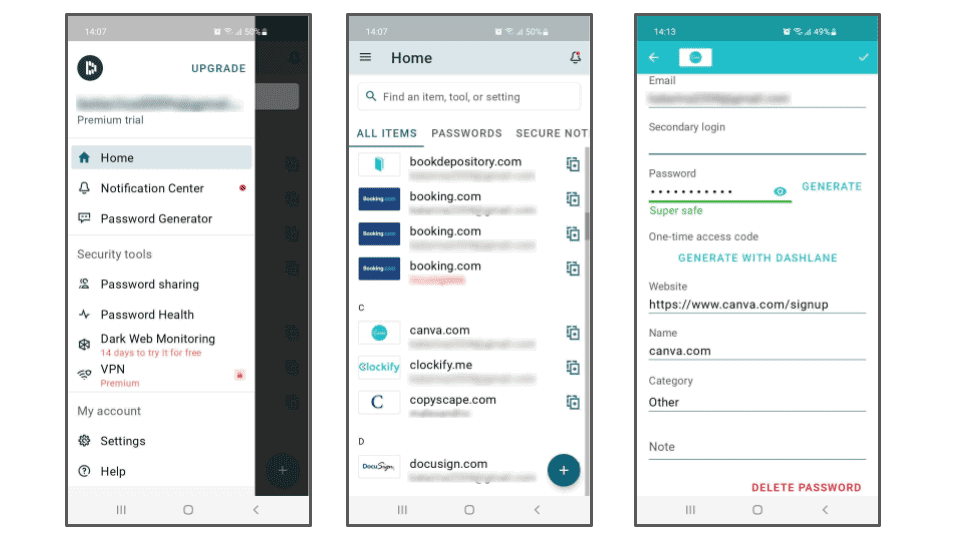
- DASHLANE PREMIUM FOR FREE CODE
- DASHLANE PREMIUM FOR FREE PASSWORD
- DASHLANE PREMIUM FOR FREE PLUS
- DASHLANE PREMIUM FOR FREE FREE
DASHLANE PREMIUM FOR FREE PASSWORD
Now you log in by entering your master password and then inserting or tapping the U2F key. During the setup, all you need to do is plug your key in and let Dashlane detect it. Dashlane requires you to add a phone number as an SMS backup, in case you lose access to your authenticator app.ĭashlane also supports U2F (Universal 2nd Factor) security keys for authentication.
DASHLANE PREMIUM FOR FREE CODE
To set up two-factor authentication, download an authenticator app, scan the QR code Dashlane shows, and then copy over the code from the authenticator app when Dashlane asks for it. You choose whether Dashlane requires the second factor on every login or just when you (or someone else!) attempts to log in from a new device. Your account is now active, but you should enable two-factor authentication before doing anything else. Your master password needs to be unguessable to others just imagine the damage someone could do if they got access to all the data stored in your password manager We strongly advise at least 12 characters, using all character sets (including symbols). Dashlane requires at least eight characters, including at least one digit, one lowercase letter, and one uppercase letter. More importantly, you need to come up with a strong master password. You then enter a code that Dashlane sends to your email address to verify your identity.

If you are a new user, you need to enter your email address and create a master password. You can also use Dashlane on Linux-based platforms and Chromebooks via its browser extensions. Dashlane offers apps for Windows, macOS, Android, and iOS. To get started with Dashlane, you first need to download the app.
DASHLANE PREMIUM FOR FREE PLUS
Previously, Dashlane offered a Premium Plus plan and Family Premium Plus plan, which added some additional identity protection features, but those plans are no longer available. However, Dashlane’s VPN doesn’t offer nearly as many features and customization options as a standalone VPN, so users who already have a VPN won’t necessarily want to switch just because it comes as part of the Dashlane bundle. You can use the standalone version of Hotspot Shield on five devices, but Dashlane puts no limit on the number of devices. It uses a licensed version of Hotspot Shield, which costs $12.99 per month, discounted to $95.88 yearly. When you factor in the usual cost of VPN protection, Dashlane’s Premium plan makes more sense. Bitwarden Premium is $10 per year, however. LastPass Premium and Keeper Password are $36 per year and $34.99 per year, respectively. For instance, Sticky Password Premium is $29.99 per year and LogMeOnce's top-end edition comes in at $39 per year.

A Dashlane Family account costs $89.88 per year (or $8.99 per month) and includes six premium licenses.ĭashlane's Essentials tier costs about the same as most other password managers. This tier adds dark web monitoring for five email addresses, a VPN, and 1GB of encrypted storage space, as well as removes all device syncing and password sharing limitations.
DASHLANE PREMIUM FOR FREE FREE
We like that this option is cheaper than the Premium tier, but the device syncing limitation seems arbitrary since several free password managers (and paid ones that are the same price or cheaper) don't include this caveat.ĭashlane Premium costs $59.88 annually (or $6.49 per month). This tier also includes Dashlane's Secure Notes feature and the ability to share an unlimited number of passwords.

The Essentials plan costs $35.88 per year (or $3.99 per month) and allows you to store an unlimited number of passwords and sync them across two devices.


 0 kommentar(er)
0 kommentar(er)
